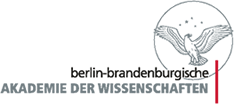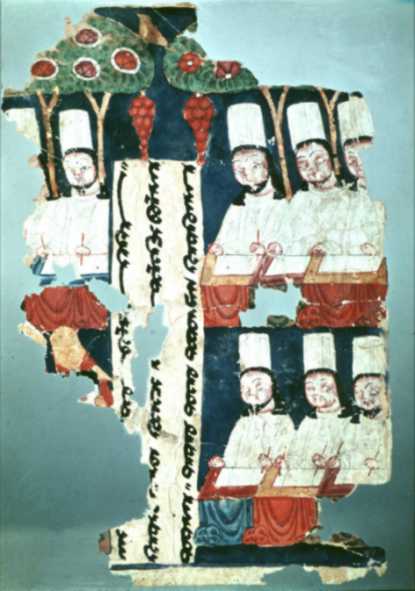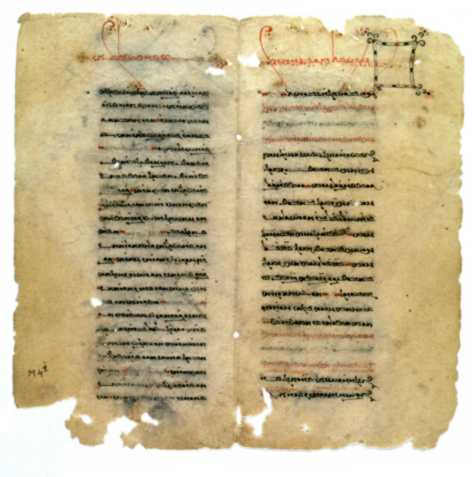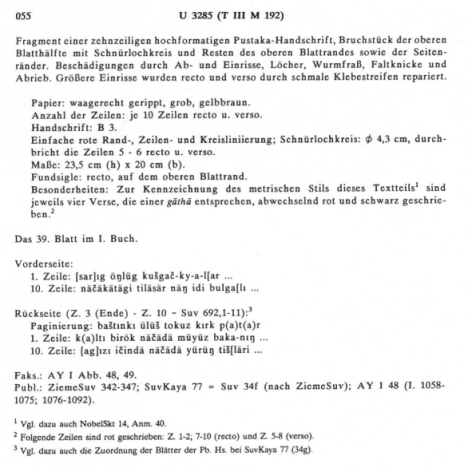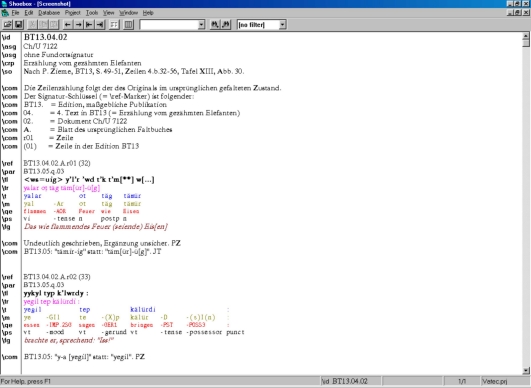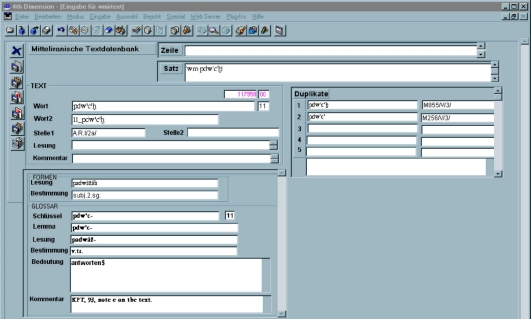Turfan Studies
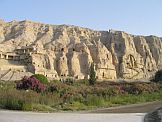 |
Article about the Turfan Studies research group |
| The brochure 'Turfan Studies' (pdf) |
'Turfan Studies', German 'Turfanforschung' is the scientific edition and interpretation of works of art and textual remains that were found in the Turfan oasis and neighbouring sites in East Turkestan (Xinjiang) and that bear manifold witness to the cultures of the ancient Silk Road. The study of the texts is the responsibility of the Berlin-Brandenburg Academy of Sciences and Humanities and of the Academy of Sciences in Göttingen. In the year 2002 the Berlin Academy together with the Museum of Indian Artand the State Library Berlin, both of which are part of the Prussian Cultural Heritage, celebrated the centenary of the start of the first German Turfan Expedition, of which there were four in all. These expeditions resulted in the greatest part of the treasures from Turfan being brought to Berlin. The fact that a hundred years after the arrival in Berlin of the first documents from Turfan a large part of the philological work on the texts still remains to be done is due to the character of the collection, the initially unknown nature of many of the languages found therein, the unfamiliarity of many words, and the bad state of preservation of the texts. The scientific gain from work on them for Oriental Studies, the study of Comparative Religions, of Literature and Linguistics has been and is all the greater.
Turfan, an oasis in East Turkestan
Scripts and languages of the texts
The Work of the Academy Project Turfan Studies
Edition of the Old Turkish texts
Edition of the Iranian Turfan texts
Cataloguing
Database for the administration of the manuscript fragments
Digital texts editions
Turfan, an oasis in East Turkestan
From the 2nd century BCE for nearly two millennia, in particular up to the end of Mongol rule in the 14th century, East Turkestan, today’s Xinjiang, was the land of exchange between East and West. An exchange the very possibility of which seemed to run counter to the harsh natural environment. In the interior is the Taklamakan, the greatest desert of Central Asia. And as if its inhospitality needed protecting it is besieged by monumental mountains: the Pamirs to the west, Tianshan to the north, Kunlun to the south. In fact, these mountains form the basis of life and civilisation. The water that was channelled from them in underground channels allowed fruitful oases to arise that were joined to each other by a network of roads first called 'Silk Roads' by F. von Richthofen in 1877. Not just valuable merchandise such as silk was transported along them and exchanged; these roads also encouraged intellectual and religious exchange to a great degree. The oases in turn became places of refuge for exiled religious groups such as the Manichaeans.
One of these oases is the Turfan oasis which takes its name from the town of Turfan (Tu-lu-pan, Turpan etc.) mentioned in old Central Asian sources. To it belong, amongst others, the ruins of Idikutšähri, the former capital of the kingdom of Gaochang and of the kingdom of the Western Uigurs (called Khocho in the Old Turkish texts), and also the cave temples of Bäzäklik and Sängim. Because the German expeditions - which took their inspiration from the discoveries made in Central Asia by Russian archaeologists and diplomats - visited the area of this oasis in particular, the name 'Turfan' came to symbolise the disciplines that concerned themselves with the, for the most part textual, remains of these formerly flowering but now mostly forgotten cultures. These disciplines range from the Art History of Central Asia to Indoeuropean, Chinese, Indological, Tibetan, Mongolian Studies and also Iranian and Turkish Studies, two disciplines that were greatly extended by the discoveries and therefore gained new profiles.
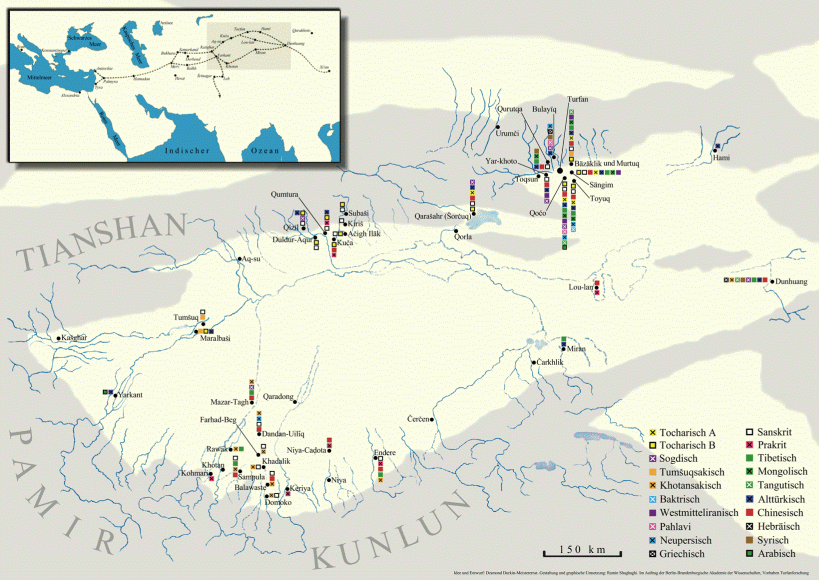
Eastern Turkestan. Places where texts were found (Map in upper left: the routes of the Silk Road)
Expeditions
It is due to a criminal prosecution that the interest of the 19th century (such as that of Alexander von Humboldt) in the natural science of the region of Central Asia including the Turfan depression, the deepest in the world, was joined by the attentions of archaeology, philology and other disciplines. In 1889 Lieutenant Bower, sent by the British colonial government to investigate the murder of a Scottish traveller in the vicinity of Kucha, was shown documents that set him on the trail of quite a different mystery. These were Sanskrit texts written in Brahmi. Other individual pieces of writing followed and news of these, together with the slightly earlier observations of geographers (S. Hedin, A. Regel) about ruined cities in Eastern Turkestan, reached West and East. In rivalry from 1899 on, archaeological expeditions from Europe and Japan struggled to get to Central Asia and got down to work between Kashgar und Dunhuang.
The Berlin Museum for Ethnology undertook under its directors A.Grünwedel and A.von Le Coq between 1902 and 1914 four expeditions in all, the last three of which were under the aegis of the Kaiser.
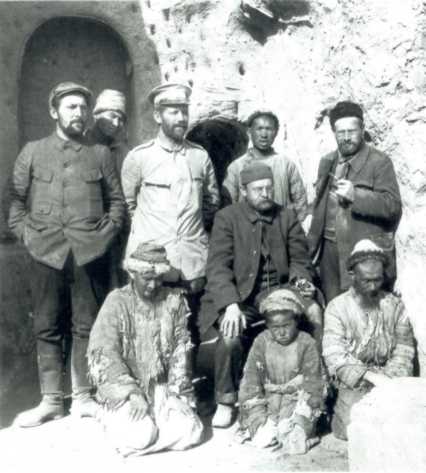
The combined second and third German expeditions. Middle row from right to left:
von Le Coq, Grünwedel, Bartus, Pohrt.
The German Turfan Expeditions
1st Expedition. Leader: Prof. A. Grünwedel; Participants: Dr. G. Huth, Th. Bartus. Route: Kulja - Urumchi - Turfan Oasis (Khocho, Bäzäklik, Sängim, Toyuq Nov. 1902 - March 1903 [paintings, statues, Mir./Uig./Np. manuscripts of the Manichaeans in Man./Uig./Runes, Ind./Chin./Tang. texts]) - northern Silk Road (Toqsun - Kharashahr - Kucha-ruins near Kumtura [paintings] - Kyzil - Aq-su - Tumshuq - Maralbashi - Kashgar). 46 crates of finds.
2nd Expedition. Leader: Dr. A. v. Le Coq; Participant: Th. Bartus. Route: Urumchi -Turfan Oasis (Khocho and surrounding areas, Yar-Khoto Nov.1904 - Aug.1905; Hami Aug. 1905; Turfan) - northern Silk Road - Kashgar (Oct. 1905; there united in Dec. with the 3rd expedition). 103 crates, mainly paintings (Bäzäklik), not so many texts (Christ. texts in Syr., Sogd., Mp., Uig.; Buddh. texts).
3rd Expedition (until June 1906 united with 2nd expedition). Leader: Prof. A. Grünwedel; Participants: A. v. Le Coq, H. Pohrt, Th. Bartus. Route: Kashgar - Tumshuq (Jan. 1906) - Kyzil - Kucha - Kumtura (Febr. 1906, temples of grottoes [paintings]) - temples of grottoes in Kyzil, Kirish (Feb. - May 1906 [paintings]), - Korla/temple complex and caves of Shorchuq [paintings, Buddh. texts] - Turfan Oasis (July 1906) - Urumchi - Hami - Toyuq (Jan. 1907) - Shorchuq (Febr./March 1907) - Turfan, return journey via Urumchi (April 1907). 118 crates of finds.
4th Expedition. Leader: Dr. A. v. Le Coq; Participant: Th. Bartus. Route: Kashgar - Kucha, Kyzil (June - Sept. 1913) - Kirish, Simsim - Kumtura (Nov. 1913) - Tumshuq (Dec. 1913 - Jan. 1914) - Kashgar. 156 crates à 75 - 80 kilos (in particular texts in Sakan and Sanskrit from Tumshuq).
The yield of these expeditions was immense. They brought thousands of items, frescos and other artefacts as well as ca. 40,000 fragments of texts in more than 20 different languages and scripts (see the graphic scripts/languages) to Berlin. Upon arrival in Berlin the fragments were taken out of the packages they had been put in for transportation and placed between sheets of glass held together at the edges with a special black tape. This method allowed the fragments to be handled without damaging them.
A. v. Le Coq, Buried Treasures of Chinese Turkestan, p.58-9:
Our expeditions arrived too late at Karakhoja. Had they come earlier, more of these remarkable Sassanian-Hellenistic paintings would certainly have been secured. We would have saved, too, very much more of the literature of the religious community, important as it is to the history of religions and languages alike; one of the peasants told me that five years before the arrival of the first expedition he had, in the ruins of one of the temples, which were pulled down to turn their site into fields, found great cartloads (araba) of those manuscripts »with the little writing« (i.e. Manichæan) for which we were making such diligent search. Many had been ornamented with pictures in gold and colours. But he was afraid, to begin with, of the unholy nature of the writings and, secondly, that the Chinese might use the discovery as a pretext for fresh extortions, so he straightway threw the whole library into the river!
A decision by the competent Ministery for Instruction in 1914 placed all the texts, except for those needed for exhibition in the Museum, in the Royal Prussian Academy of Sciences of the time. Two years previously, on the 5th of May 1912, the 'Oriental Commission' was founded in the Academy of Sciences. Its purpose was to coordinate and support the scientific work on the finds from German expeditions to the Orient.
Under the aegis of the Oriental Commission it was also possible to entrust the Turfan texts to representatives of the various disciplines for editing. The Commission was active up to the end of the Second World War. During that war the Turfan fragments had to be removed for safety. They were stored, for example, in disused salt mines in Wintershall, Solvayhall and Schönebeck/Elbe.
After the war the, for the most part undamaged, fragments were transferred to the German Academy of Sciences (Deutsche Akademie der Wissenschaften), newly founded in 1946. However, a small part found its way to the Academy of Sciences and Literature in Mainz. Some Iranian fragments were lodged in the Orientalisches Seminar of the University of Hamburg. Other fragments, mostly of Sanskrit texts, were sent to Göttingen.
In 1956 the Iranian fragments in Hamburg were sent to Mainz. When the State Library, Prussian Cultural Heritage was founded in Marburg all the fragments in Mainz were transferred to Marburg. From there they moved with the State Library into the new building in the Potsdamer Straße in Berlin. Since 1992 all the parts of the collection are again united under the ownership of the Berlin-Brandenburg Academy of Sciences and Humanities, the successor of the Prussian Academy of Sciences. Nevertheless, only those texts currently needed are in the building of the Berlin Academy (ca. 13,000 Iranian and Turkish fragments). The others are stored in the Oriental Department of the State Library, which has undertaken the curatorial management of the whole collection. The art objects found in Turfan and illuminated manuscripts can be seen and admired in the Museum for Indian Art.
Corresponding to the division of the collection as a result of the Second World War, work on the fragments continued under difficult circumstances. In 1947 the Institut für Orientforschung (Institute for the Study of the Orient) was founded in the German Academy of Sciences where the Turfan Collection found a new home. Experts from all of Germany continued to work on the texts. When the Berlin wall was erected the conditions for working on the texts in each other part of Germany became much more difficult and partly impossible. Nevertheless there was fruitful cooperation amongst colleagues. In 1965 Wolfgang Steinitz and Georg Hazai founded the Turfanforschungsgruppe (Turfan Study Group) in the Institut für Orientforschung. From 1969 to 1991 work on the Turfan texts was situated in the department »Alter Orient« (the Ancient Orient) of the Central Institute for Ancient History and Archaeology of the Academy of Sciences of the GDR. Since 1992 the work of the Academy project (Akademienvorhaben) »Turfanforschung« at the Berlin-Brandenburg Academy of Sciences and Humanities (BBAW) has concentrated on the edition of the Iranian and Turkish fragments. Catalogues of the fragments of these groups of texts are being compiled as part of the Academy project 'Union Catalogue of Oriental Manuscripts in German Collections' of the Academy of Sciences in Göttingen.
As regards text materials from the oases on the northern Silk Road, the Berlin Collection is the richest and most significant in the world. It contains the greatest number of Manichaean original texts from Central Asia. Unique treasures are also the fragments of Christian texts in Sogdian, Bactrian fragments in 'Hephthalite' script and fragments in Old Turkish Runes.
The age of the fragments varies greatly. The oldest fragments, containing Indian drama, date from the 2nd c. CE. This moved the date for the beginning of Indian drama back a number of centuries. The oldest fragments in the Chinese collection are from the 4th to 5th centuries. The Iranian fragments date to the 8th to 11th centuries. Most of the Old Turkish fragments are from the 9th to 14th centuries.
Finds from sites on the southern Silk Road, from Turfan and particularly from Dunhuang are now in the British Museum and the British Library in London, the Bibliothèque Nationale in Paris, the Eremitage and the Orient Institute of the Russian Academy of Sciences in St. Petersburg, in the Ryūkoku University in Kyoto and in other collections.
The decades of scientific cooperation not only result in a sharing of knowledge but also have a practical side such as joining fragments that happen to be in different collections.
The fragments display different book formats. These range from the familiar codices for Manichaean and Christian books to the book rolls favoured by the Chinese. Buddhism brought to wide currency a book format from India consisting of palm leaves (pustaka). These pustakas are as a rule oblong (width to height in a proportion of 3 to 1) with a hole in the first third of the page. Of the printed books that first appear in the 9th century the most popular form amongst the Uigurs is the 'accordion book' (leporello). Printed books are a small but significant part of the Turfan material. They were not printed with type but with carved wooden blocks that contained whole pages. These 'block prints' were probably mostly made in Chinese workshops but they have been found in many sites of the Turfan oasis. They contain Chinese, Tangut, Mongolian, Tibetan, Old Turkish and Sanskrit texts and most can be dated to the 13th/14th centuries. Except for some printed calendars, the texts are primarily Buddhist since a Buddhist performed a good deed when he reproduced texts. Therefore printed versions often exist side by side with handwritten Turkish texts. Jātakas (Stories about the previous lives of the Buddha) have also survived as block prints with illustrations in the upper third of the folded pages. However, only a few printed books are fully preserved.
Besides varieties of locally produced paper particularly good paper from China is preserved. The smaller proportion of texts is written on palm leaves, birch bark, wood, silk, parchment or stone.
Most of the texts are religious in content. They testify eloquently to the religious communities in the oases on the Silk Road and to the spread of the three world religions Buddhism, Manichaeism and Christianity.
In the Kitāb al-ḥayawān, al-Ğaḥiẓ related the following:
Ibrāhīm asSindī once said to me:
»I wish the Zandiks [i.e. the Manichaeans] were not so intent on spending good money on clean white paper and for the use of shining black ink and that they would not put such great value on calligraphy und would encourage the calligraphers less; because indeed no paper that I ever saw is comparable to the paper of their books and no calligraphy with that which is used therein.«
I replied to Ibrāhīm:
»When the Manichaeans go to great lengths for the decoration of their holy books it is the same as when the Christians do it for their churches«.
(Translation of a quote from K. Keßler: Mani. Forschungen über die manichäische Religion. Berlin 1889, S. 366)
Remains of literary works and numerous profane texts were also found. Fragments of dictionaries, lists and grammars attest to a preoccupation with the various languages. Most of the religious texts are translations, from Syriac into Iranian languages, or from Tocharian into Old Turkish or, as is the case for most of the Buddhist texts, from Chinese into Sogdian or Old Turkish, to name just a few. Fragments of scientific texts, e.g. medical or astronomical, or also texts from daily life and customs such as omens or dream interpretations, divinations or calendars have survived. Of great importance are, of course, the economic and legal notices from monasteries and private households, from private and state archives mostly written in Old Turkish. Tax bills, corvée accounts, laissez-passer and various lists have also survived. Documents about buying and selling, tenancy and usufruct, slaves and property etc. were composed and testify to a broad familiarity with writing. It is clear, at least, from many Old Turkish documents that the initiator was often the writer. Additionally there were professional scribes who dealt with worldly texts, whereas in the monasteries most likely it was the monks themselves who wrote and copied the holy texts. On the assumption that only a fraction of the written materials that once were in the libraries and other places has survived the original quantity must have been immense. Particularly as regards the Manichaean material this loss is highly regrettable. The Manichaeans were not only the representatives of a special religious system presented by its founder as the last and best of all previous teachings, they also expended all their energy on the artistic realisation of their beliefs: They produced books the splendour and elegance of which were intended to outshine everything that went before and that apparently did become a model for later generations.
Manichaeism - »the teaching of the two principles«
Mānī (216-277), of Parthian aristocratic stock, founded Manichaeism in Mesopotamia with the aim of bringing the other religions of his time together. On a Judaeo-Christian base, enriched with Gnostic, Zoroastrian and Buddhist elements, a religion with a universalistic claim developed, whose central teaching was dualism, the struggle between the good, bright, and the bad, dark principles. The main task of a Manichaean was to free the light trapped in the material world and to lead it up to the Paradise of Light. Manichaeism spread in very many lands of the ancient world (in the west as far as Rome and North Africa; in the east as far as the south-east coast of China). From 762 to 840 it even was the state religion in the Uigur Kingdom. Pushed back by persecution and wars, Manichaeism disappeared entirely in about the 14th c. Testimonies and parts of Manichaean literature have been preserved in many languages.
Scripts and languages of the texts
The scripts and languages of the texts are surprisingly manifold, but the groups of Sanskrit, Old Turkish, Chinese, Middle Iranian and Tocharian texts are the largest.
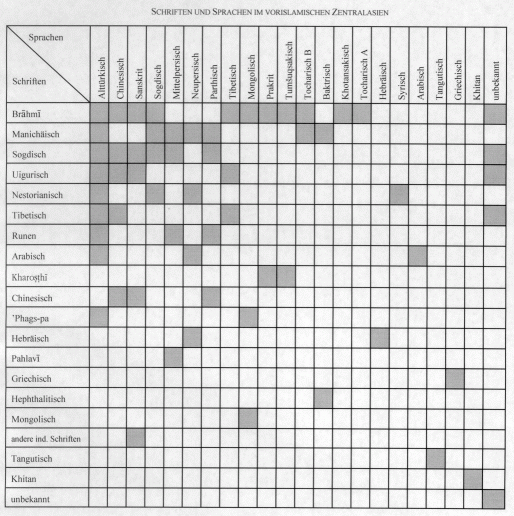
Scripts and languages of the texts
After the ground-breaking editions by H. and E. Lüders the Sanskrit texts from the Turfan Collection have been edited since 1950 by E. Waldschmidt and his pupils and collaborators first at the German Academy of Sciences (Berlin) and since 1965 at the Academy of Sciences in Göttingen. The detailed descriptive catalogue of the Sanskrit manuscripts in the Turfan Collection (begun by E. Waldschmidt and up to Part 5 written by him or under his guidance) is part of the project 'Union Catalogue of Oriental Manuscripts in German Collections', which has been a project of the Academy of Sciences in Göttingen since 1990; the latest issue is Part 9 (2004), edited by K. Wille. Additionally since 1973, also as a project of the Academy in Göttingen, the 'Sanskrit Dictionary of the Buddhist Texts from the Turfan Collection and of the canonical literature of the Sarvāstivāda school' (Editor: H. Bechert, Scientific editor: M. Schmidt) has been appearing; a third of the dictionary has by now been published.
The main task in the work on the Chinese texts, which is being carried out in cooperation with Japanese colleagues, is to identify and catalogue the fragments because most of them are remnants of otherwise well preserved Buddhist books.
The Tocharian texts were edited by E. Sieg and W. Siegling. Because of their great importance for Indoeuropean studies they are in the process of being re-edited by colleagues in Frankfurt a.M., Saarbrücken and Uppsala and are presented in the TITUS project in an exemplary manner.
The Syriac texts have not yet been edited. Though the relevant scientific community has shown great interest it has become clear that a long-term and exclusive concentration on the material is necessary to allow results to be presented.
Devoted to making the Middle Iranian and Old Turkish fragments accessible and available is the Academy project 'Turfan Studies' of the BBAW, which will be presented here, and also the Arbeitsstelle Berlin 2: Turfanforschung of the 'Union Catalogue of Oriental Manuscripts in German Collections' ('Katalogisierung der Orientalischen Handschriften in Deutschland', KOHD) of the Academy of Sciences in Göttingen. The close cooperation of both Academy projects developed in the work to the present is also in the future an indispensable precondition for scientific success.
The Work of the Academy Project Turfan Studies
The religions already mentioned were also present among the Turkish peoples, particularly the Uigurs who after the collapse of their powerful empire of the steppes after 840 CE founded the West Uigur kingdom with its capital Khocho (Gaochang). Predominantly from the villages Bulayïq and Kurutka in the Turfan oasis Christian texts in Syriac, Sogdian and Turkish came to light. Manichaean Turkish texts come from many temple ruins in Khocho itself but also from other places in the oasis such as Bäzäklik and Toyuq. They are written not only in the Manichaean, but also in the Uigur script and in Turkish runes, otherwise known only from inscriptions in Siberia and Mongolia, and comprise a broad spectrum of Manichaean literature, furthermore letters, monastic decrees etc. that give us in insight into how Manichaeism »had installed itself in the world«, to use the words of an untimely deceased member of the commission guiding the Turfan project, H.-J. Klimkeit.
Old Turkish
After the first stage of Old Turkish (runic inscriptions from many regions of Asia from Mongolia as far as the Carpathian Basin, ca. 6th - 10th c.) a second stage is represented by the pre-Islamic texts from Turfan and Dunhuang. This Central Asian Turkish is a koiné-type literary language that, on phonological and morphological criteria, is divided into about three dialects: Manichaean Turkish, early Buddhist Old Turkish [Uigur A] and Buddhist Old Turkish [Uigur].
Apart from the early inscriptions from Karabalgasun of the 8th c., the literary remains of the Uigur Manichaeans date from the 10th and 11th centuries and are located in the Turfan oasis and Dunhuang, whereas Christian manuscripts probably from the 12th and 13th centuries were found in Khocho, Bulayïq, Kurutka and further east in Qarakhoto. The Buddhist literature presents an entirely different picture. In the whole period from the 10th to the 14th centuries Buddhist works were read, copied, translated and modified. The texts were also geographically more widely spread than those of the other religious communities. The number of fragments illustrating all the facets of Buddhism amongst the Uigurs rises to thousands and forms the major part of the ca. 8000 Old Turkish fragments. When we consider that this is only a small part of what was once translated, written down and put into verse then we must recognize that Buddhism really flourished in the later phase of the Uigur kingdom.
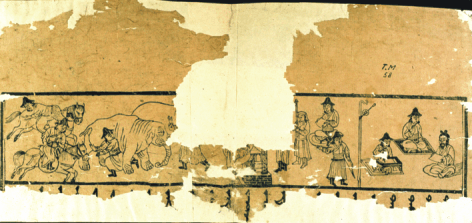
Page of a block print of the Old Turkish version of Viśvantara-Jātaka. Illustrations in the Uigur-Mongolian style.
Edition of the Old Turkish Texts
In 1904, shortly after the return of the first Turfan Expedition with its stupendous results, F. W. K. Müller, the acting director of the Museum for Ethnology edited the first Turkish Manichaean text. In the same year, K. Foy attempted a first description of the language of the Turkish Manichaean texts. But it was A. von Le Coq who was to publish not only the Manichaean miniatures in a splendid facsimile volume but also to edit the Manichaean Turkish text fragments in three studies ('Türkische Manichaica aus Chotscho', I-III [1911-1922]). W. Bang re-edited some of them between 1923 and 1926 and in 1930 edited together with his student A. v. Gabain, parts of the difficult 'Great Hymn to Mani the Father' which Le Coq had not dared to translate (work on this text was continued by A. von Gabain with W. Winter 1958 [TT IX] and by L.V. Clark 1982). Work on the Manichaean texts was taken up again only at the end of the 60s when P. Zieme published a series of fragments, particularly in BTT V.
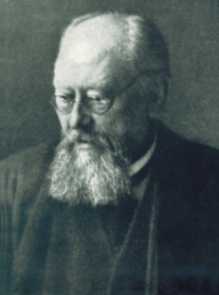
F. W. K. Müller (1863 - 1930)
F.W.K. Müller turned to the Christian but even more so to the Buddhist Turkish literature with his series 'Uigurica' beginning in 1908 and of which A. v. Gabain published the fourth part in 1931 from Müller’s papers. In 1929 W. Bang and A. v. Gabain started the series 'Türkische Turfantexte' that eventually comprised ten numbers and in which G.R. Rachmati later cooperated (TT VI, VII). It was also A. v. Gabain who prepared a facsimile edition of the fragments of the Maitrisimit. A facsimile edition of 'Uigurica I-IV' was edited in 1983 by G. Hazai and P. Zieme. Most of the publications mentioned have been made easily available in the multi-volume reprint 'Sprachwissenschaftliche Ergebnisse der deutschen Turfan-Forschung' (1972-1985). In 1941 A. v. Gabain presented with her 'Alttürkische Grammatik' a systematisation of her editorial work on the fragments. Replete with references and clearly structured, this grammar immediately became an instrument of the following generations of Turcologists. She also formed the plan for a 'Uigur Dictionary'; this is being carried out by K. Röhrborn (1977-1998; six fascicles to date). G. Clauson wrote an etymological dictionary of Old Turkish in 1972, the Turcologists in St. Petersburg made a reference dictionary in 1968. A. v. Gabain dealt with problems of language, script, book culture and literature. Ş. Tekin published a study of the old book formats of the Uigurs. M. Erdal produced a ground-breaking study of Old Turkic word-formation and has also studied phonological problems. Just recently he published a new 'Grammar of Old Turkic'.
The scientific work on a text results in an edition that, depending on the fragments, has more or less the following structure:
a) an inventory of the fragments; b) attribution of the fragments to manuscript groups and description of these; c) transliteration of the individual fragments; d) compiled text (depending on the language also in transcription), if more than one manuscript was found, often an attempted reconstruction of the original work; e) translation of the text; in the case of a translated text a detailed comparison with the original (actual or assumed), as far as possible; f) commentary on the contents and on linguistic and religious problems and/or those relating to cultural history and even, as necessary, on economical problems; g) indices, complete word index and/or a terminological index. In recent years is has become usual to include the edited texts as photo-facsimiles. The Turfan editions are intended to provide the basis for further studies in all the relevant areas ranging from codicological to religious studies.
A first survey of the Buddhist literature by J. Everskog in 1997 details 83 works and since then the numbers of works identified has risen. If we include new discoveries such as those in the Northern Grottoes of Mogao (near Dunhuang) or the recovery of new texts from the collections in Berlin and St. Petersburg we can optimistically expect the number to rise further. Some of the great Mahāyānasūtras such as Vimalakīrtinirdeśasūtra, the Saddharmapuṇḍarīkasūtra ('Lotus-Sūtra'), Suvarṇaprabhāsottamasūtra ('Sūtra of Golden Light'), the Sukhāvātīyūhasūtras, Guanwuliangshoujing, Vajracchedikāsūtra and other Mahāprajñāpāramitā texts are present, also commentaries translated by monks.
Thanks to the untiring work of Taiwanese Buddhists and scholars the complete Chinese canon in the Taishō edition has meanwhile been digitised and placed on the web thus making it much easier to identify fragments. Therefore in the future it will be possible to find out more quickly if a particular text is a translation of a known text. This will allow us to establish which works are preserved only in the Uigur tradition. However, there are still many manuscripts to be studied, edited and published.
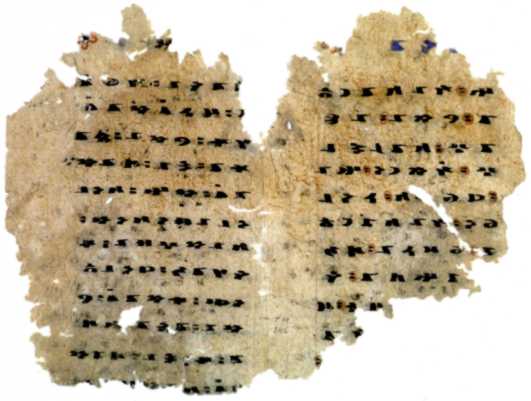
The Uigur text in runes (U 5)
In numerous publications, works of Uigur Buddhism have been presented (see publications in the Appendix). The manuscript of the Insadi-Sūtra edited by S. Tezcan (BTT III) is one of the texts of the Berlin collection that is most difficult to read. It is becoming ever more clear that it is an independent version of various Buddhist sources.
The relatively late works of Tantric Buddhism that show Tibetan influence were edited in a long-term cooperation by G. Kara and P. Zieme. These include Sādhana texts, the Cakrasaṃvara Cycle, a Guruyoga, Mañjuśrīnāmasaṃgīti and a version of the Book of the Dead from Dunhuang (BTT VII, BTT VIII, Zieme-Kara Totenbuch).
Buddhism in Central Asia
The teaching of the Buddha which arose in northeastern India gained from the time of Aśoka, the ruler of the Maurya dynasty in the 3rd c. BCE and especially after the first century BCE an ever growing following also outside of India. In this the Central Asian caravan routes played an important role as an early missionary route to China and East Asia. Of Buddhism of the ‘smaller vehicle’ (Hīnayāna) two schools in particular, the Sarvāstivāda and the Mūlasarvāstivāda were active on the northern Silk Road, but the Vaibhāsika school, a further division of the Sarvāstivāda, was also widely spread. With the development of Mahāyāna Buddhism new impulses originated in China and found fertile ground in the oases of Central Asia, particularly in Khotan and in the Turfan Oasis. Testimonies of the cults of Maitreya and Avalokiteśvara as well as of the school of the Pure Land (Amitābha Buddhism) appear in great numbers. The close connection between Turfan and Dunhuang, particularly at the time of the kingdom of the West Uigurs led to, amongst other things, the spread of Dhyāna (> Chan > Zen). In the late phase, the Yuan Period (13th/14th c.), Tantrism flourished under the influence of Tibetan and Mongolian masters.
A series of articles by K. Kudara and P. Zieme deals with bilingual excerpts (Chinese - Old Turkish) from the Āgamas. Similar bilingual Buddhist texts are a copy of the Biography of Xuan Zang in the Berlin Collection and the Bathhouse Sūtra. Furthermore, the authors edited a versified version of the meditational sutra Guanwuliangshoujing, a sutra of the school of the Pure Land hitherto known only in its Chinese version which is in prose.
Buddhist confessional texts that have attracted the interest of Turcologists since Türkische Turfantexte IV were edited by K. Röhrborn, I. Warnke and J. Wilkens.
On the basis of 60 Berlin fragments it was possible to re-establish the text of the first book of the Sutra of Golden Light (Altun Yaruk Sudur) so badly preserved in the St. Petersburg fragments and to present an edition in 1996 (see BTT XVIII). This fills a gap in the Uigur tradition of this important Mahāyānasūtra that was translated into many languages of the Buddhist countries (Chinese, Tibetan, Mongolian, Tangut etc.). A chapter dealing with the Buddha’s three bodies was edited by J. Wilkens in 2001 (BTT XXI).
The Vimalakīrtinirdeśasūtra is a Mahāyānasūtra the Indian original of which was regarded lost except for a few quotes in other texts. Recently, a Japanese group of scholars published a complete manuscript on palm-leaves of this significant work from the collection of the Potala palace in Lhasa. Besides this, translations into Chinese, Khotan Saka, Sogdian, Tibetan and Mongolian are known. To these a translation into Old Uigur of a third of the text recovered from the Turfan fragments can be added (see BTT XX).
A research prize granted by the Alexander von Humboldt Foundation to G. Kara has allowed and continues to allow him to cooperate with P. Zieme. They work together on a collection of Uigur tantric sutras in which Avalokiteśvara the Bodhisattva of Great Compassion plays a central role. These works translated from Chinese will be compared to the originals.
In 2005 P. Zieme published an edition of Yetikän sudur ('Sūtra about the Great Bear') and similar Buddhist works dealing with the stars (s. BT XXIII).
Besides editions of a commentary on the Vimalakīrtinirdeśasūtra and of Amitābha texts, editions of Chan-Buddhist texts, of a collection of Uigur translations of the Lotus Sūtra and of alliterative poetry with Buddhist content (as a continuation of BTT XIII) are planned. The very extensive and broadly represented collection of tales Daśakarmapathāvadānamālā (»Garland of legends referring to the ten paths of action«) will be presented in a comprehensive edition. Shortly, Y. Kasai will publish her study of Buddhist colophons in BTT.
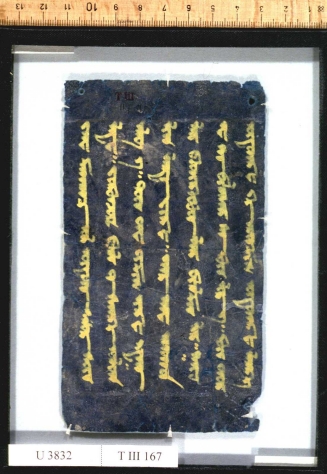
Fragment of a Uigur text (U 3832)
This page has only just been published in BTT XXIII. U 3832, which is probably from Murtuq, is from a magnificently made book with golden yellow letters on a dark blue background. The text is a Tantric Buddhist one and is from an Old Turkish translation of the Tantric work Fo shuo pishamen tianwang jing (= *Vaiśravaṇa-devaraja-sūtra) 'The Sūtra about the King of heaven Vaiśravaṇa, preached by the Buddha' which is identical to the Ātānātikasūtra attested in Sanskrit. On the page shown here Vaiśravaṇa, one of the four guardians of the world (lokapāla) speaks verses praising the Buddha.
Though the numerous religious texts dominate in the editorial work there is occasionally an opportunity to work on the above-mentioned profane texts which contain just a few literary genres but which provide information about the real circumstances and objects of interest of the societies in the Central Asian oasis-states and therefore are an important source for the previously badly documented history of the Turkish peoples.
Already early on W. Radloff worked on these secular texts, but they only appeared in 1928 in his posthumous book 'Uigurische Sprachdenkmäler'. His student, S.E. Malov continued his work in St. Petersburg; in Berlin it was G.R. Arat who prepared a large-scale study of Uigur documents (unpublished; in his papers, held in trust by O.F. Sertkaya, there are numerous photographs of texts the originals of which must be presumed lost). His 'Eski Türk Hukuk Vesikaları' which appeared in 1964 formed the basis for the further studies of L.V. Clark ('Introduction to the Uyghur Civil Documents of East Turkestan 13th - 14th cc.', 1975) and of Japanese scholars, in particular N. Yamada, whose posthumous work finally appeared in the »Sammlung uigurischer Kontrakte« (edited by T. Moriyasu, J. Oda, H. Umemura, P. Zieme) in 1993. S. Raschmann published a collection of important references in her book 'Baumwolle im türkischen Zentralasien', 1995. D. Matsui published Uigur documents and contributed so to the study of the society and economy of the Yuan period. He intends to publish 'Uigur Administrative Orders during the Mongol Period' in BTT. T. Moriyasu will also present his edition of Uigur letters in BTT.
A few book rolls and books amongst the Middle Iranian material are relatively well preserved. The latter include the group of Christian Sogdian texts. From numerous pages found in Bulayïq codices can be reconstructed. One of the pearls of the collection is an incomplete booklet, whose pages are in the wrong order, published under the name Bet- und Beichtbuch. But the vast majority of the Turfan texts consist of single pages (though sometimes pages in sequence are preserved), for the most part, fragments of pages. Torn from books, the pages were found by the explorers strewn on the ground or they bought them from the farmers in the area. The date of the destruction is unclear and it may be assumed that the conditions under which the fragments were found contributed to further fragmentation. Some pages were never part of a book: they were the by-products of a scriptorium.
Despite the rather desolate state of many fragments the texts are, for various reasons, retrievable. Many texts are relatively short hymns, two or three of which could fit on a page. Or, since copies of the texts were made and, moreover, many manuscripts contained collections of miscellaneous texts, it is possible that one and the same text is present in a number of copies. Therefore one of the achievements of Turfan Studies is to compare meticulously and to confront these fragments with each other in a synopsis. The particular character of the collection means that a scholar working on a text has to be familiar with the whole collection, since that text may be present in it more than once and even in a form difficult to recognize. It has been shown that decisive information can be gained even from an apparently insignificant fragment. Part of the work (and at the same time one of its results) consists of the reconstruction of the original codices. On the basis of page size and writing type a relatively large number of codices have been recognized. These often contain collections of texts in various languages (Middle Persian, Parthian, Sogdian and Uigur).
Manichaean scribes. Page from a book from Khocho.
Translation of the Old Turkish lines in the cartouche:
»When one believes [heretics(?)],
when one believes those who follow wrong teachings,
when there are unbelieving begrudgers, [greedy] wanters,
then one must recognize that everything [is perishable(?)].«
(from an unidentified Manichaean text).
Amongst the languages preserved in the fragments from Turfan the Middle Iranian languages Middle Persian, Parthian, Sogdian, Sakan and Bactrian (one fragment in Manichaean script and the »Hephthalitenfragmente«) are represented. At the time of the discovery of the Turfan texts, of all these languages only Middle Persian in the form of Book Pahlavī, the language of the Zoroastrian books, was known, other sources for these languages had either not been recognized or interpreted or even found (Middle Persian and Parthian inscriptions, Sogdian letters and documents, Bactrian documents). Information on these languages, e.g. in al-Bīrūnī’s writings, came into its own only when work started on the texts which (together with the discoveries from other places in Central Asia) allowed a whole series of Middle Iranian languages to step forward and so extended enormously our knowledge about the history of the Iranian languages and about the cultures along the Silk Road.
In the case of the Middle Persian texts the language of which was already known in the form of Zoroastrian Middle Persian, the fact that the texts from Turfan are written in the clear Manichaean alphabet and have for the most part not been subject to massive influence by New Persian in their transmission has had consequences for the interpretation of the orthographically very opaque Zoroastrian Middle Persian transmitted in late manuscripts. The possibility afforded by the Turfan texts of distinguishing the closely related languages Middle Persian and Parthian according to clear criteria led to a general clarification of the linguistic situation in the west of Iran in the Middle Iranian period and has also had effects on the recognition of Western Middle Iranian loanwords in Armenian and in Aramaic dialects.
Even today the Parthian texts from Turfan still are the most important source for the study of this language. The Sogdian texts from Turfan have, on the basis of their quantity and varied contents, a prominent position amongst the various and widely scattered sources for this language. The Middle Persian texts from Turfan are an important reference point for Zoroastrian Middle Persian. The Sakan texts from Turfan join the extensive finds from the Sakan language areas proper in the west of Central Asia. The few Bactrian texts from Turfan, that have eluded convincing interpretations, can hopefully now be interpreted with the help of the various discoveries of Bactrian texts from Afghanistan (particularly in the last twenty years).
F. W. K. Müller discovered in the first texts sent to Berlin not only Middle Iranian languages but also original Manichaean texts. Texts thereby came to light that were from Manichaeans themselves and not, as was the case with most of the texts known up to then, from the bitter enemies of this religion or from slightly more objective Arabic historians, and therefore opened a new door on Manichaeism. Work on them has given new impulses to the study of Manichaeism and Gnosis. Later discoveries of Manichaean and Gnostic texts - especially in Greek and Coptic - have led to a more profound understanding of the texts of Eastern Manichaeism and allowed their relative position to be established. As far as the Parthian and Middle Persian Manichaean texts are concerned, it is important to note that many of them were composed in Iran and not - quite unlike the Sogdian and even more the Uigur texts - in Central Asia, where they were just copied. For the most part, though, we have copies from the 8th - 11th c. (i.e. 400-500 years after the texts came into existence) made first by Western Iranians and later by Sogdians or Turks. This can be seen in the names that are sometimes placed at the end of paragraphs in the texts.
The Christian and Buddhist texts do not have a pre-eminent position comparable to that of the Manichaean texts. They are often translations that are less well preserved than the originals in other languages. Nevertheless, they are eloquent testimony to the spread of Buddhism and Christianity in Central Asia. Christian Sogdian texts were found together with Syriac texts and belong to a bilingual Christian community that is part of the Syriac speaking Nestorian community that was also widespread in the Sasanian Empire. Besides translations from the Gospels various ecclesiastical texts are present the Syriac originals of which are often also extant. These are a great help in understanding the Sogdian versions that, in turn, contribute to the history of the transmission of the text.
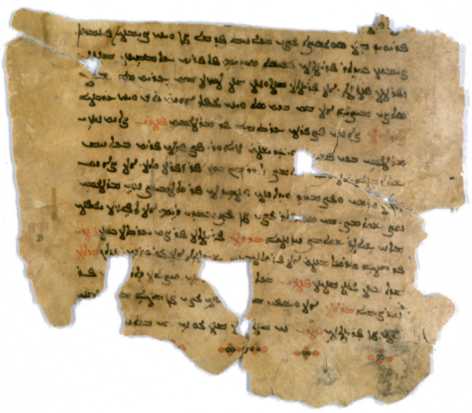
The illustration shows the bottom half of a page (n 493 recto) in slightly modified Syriac script (Estrangelo) and Christian Sogdian language. The text, a translation from an identified Syriac original, contains a dialogue between a younger monk who poses questions and an older monk who gives answers; it belongs to the Apophthegmata Patrum. The speakers are indicated in the text by the words written in red ptry (›father‹ for the older monk) and br’t (›brother‹ for the younger monk). The page belongs to the large Sogdian codex C 2 and was edited by N. Sims-Williams (BTT XII: Folio 61 R on p. 129).
A unique Christian text is the fragment of the Psalter that found its way to Turfan: It is written in Middle Persian in a variant of the Pahlavī script (that of Sasanian Middle Persian) and is a rare piece of evidence for a Nestorian Christian community’s switch to Middle Persian.
The religious affiliation of a text is important not only for its terminology and comprehension, as a rule it also says something about its origin. Certainly many Middle Persian and Parthian Manichaean texts are translations from no longer extant original texts in an Aramaic language. The Manichaean literature in other languages, in particular the rich Coptic Manichaean literature also contains in part translations and adaptations of the same originals. On the other hand, Chinese translations and adaptations of Parthian Manichaean texts and some Sogdian versions of Parthian texts (Sermon about the Light-Nous; Sermon of the Soul) exist. Most of the preserved Sogdian texts are translations and adaptations of identified Syriac (in the case of Christian Sogdian) and Chinese (in the case of Buddhist Chinese) originals.
This interdependancy that testifies to what is a special feature of the Silk Road, namely that it was a link not only between trading posts but also between cultures, languages and religions, provides us with many avenues for interpreting the texts and demands of those working on the texts much competence and the willingness to consult with colleagues from neighbouring disciplines.
Edition of the Iranian Turfan Texts
When F. W. K. Müller had deciphered what was later to be called the Manichaean alphabet he was able in 1904 to present Middle Persian and Parthian texts in transcription and translation; these were reedited by C. Salemann in 1908 who added a dictionary, grammatical notes and an index a tergo.
The Manichaean page M 4a / I / V /, / II / R/
On the right-hand side of the illustration is a short hymn in Parthian in Manichaean script which F. W. K. Müller published already in 1904 and for which M. Lidzbarski 1918 conjectured an Aramaic original on the basis of the phraseology and which he even reconstructed. Since Mānī on another occasion says: ›I am a doctor from Babylonia‹ (bzyšk hym ’c b’b[y](l) z(m)[yg ] M48+/I/R/18-19/), the text may refer to him.
Transliteration Transcription
3/ nys’r’d mwqr’nyg b’š’ nisārād muqrānīg(?) bāšā
4/ ’bjyrw’ng ‘šnwhrg hym abžīrwānag išnōhrag hēm
5/ cy ’c b’byl zmyg čē až bābēl zamīg
6/ wyspryxt hym ˚˚ wyspryxt wisprixt hēm ˚ wisprixt
7/ hym ’c zmyg b’byl ’wd hēm až zamīg bābēl ud
8/ pd r’štyft br ’wyšt’’d pad rāštīft bar awēštād
9/ hym ˚˚ ˚˚ sr’wg hym ’bjyrw’ng hēm˚ ˚ sarāwag(?) hēm abžīrwānag
10/ cy ’c b’byl zmyg frnft čē až bābēl zamīg franaft
11/ hym ˚˚ frnft hym ’c zmyg hēm ˚ franaft hēm až zamīg
12/ b’byl kw xrws’n xrws pd bābēl ku xrōsān xrōs pad
13/ zmbwdyg ˚˚ ˚˚ ’w ‘šm’ yzd’n zambūdīg ˚ ˚ ō išmā yazdān
14/ pdwh’m hrwyn bg’n hyrzydw padwahām harwīn baγān hirzēd
15/ ’w mn ’st’r pd ’mwjdyft ˚˚ ō man āstār pad āmuždīft ˚˚
16/ hnjft mwqr’nyg b’š’h hanjaft muqrānīg(?) bāšāh
Translation
Begun is the Muqrān(?) hymn
I am a grateful student, who am sprouted from the land of Babel (= Babylonia).
I sprouted from Babylonia, and have stood at the gate of truth.
I am a young student, who am gone forth from Babylonia.
Forth I went from Babylonia, so that I might call a call in the world.
I beseech you gods: All the gods, forgive my sin(s) with mercy!
Finished is the Muqrān(?) hymn
As yet the two closely related languages, Parthian and Middle Persian, could not be distinguished. This was done systematically and comprehensively by P. Tedesco 1921 in a dialectological study. New editions of texts were presented by E. Waldschmidt and W. Lentz 1926 and 1933 in studies on the religious contents of the texts and by W.B. Henning 1932, 1933 and 1934 (from F.C. Andreas’ papers) and in numerous articles, in particular by W.B. Henning. This work was continued by M. Boyce 1954 and W. Sundermann, the editor in charge of the Iranian texts since 1970 (»Arbeitsstellenleiter« from 1992 until 2000). In 1975 M. Boyce collected many of the texts published up to then. Scholars from all over the world have edited groups of texts or individual texts. The Christian Middle Persian psalter fragment was published in 1933 by K. Barr from F.C. Andreas’ papers. Grammatical studies on Western Middle Iranian first concentrated on the verb in Middle Persian 1933 (W.B. Henning) and in Parthian 1939 (A. Ghilain). Chr. Brunner published a Syntax of Western Middle Iranian in 1977.
Editions of more extensive text material usually contain a glossary. M. Boyce compiled a Word-list in 1977 of the texts she published in 1975. Within the Manichaean Dictionary Project of the School of Oriental and African Studies, University of London, a dictionary of the published Parthian and Middle Persian texts has been compiled. But a comprehensive dictionary of all Western Middle Iranian texts is still a long way off.
F. W. K. Müller soon turned to the study of Sogdian (1913 and from his papers Müller-Lentz 1934), a language, prior to the discoveries in Turfan, known only from legends on coins and from the reports of historians writing in Arabic. Whilst he called this language a »Pehlevî-Dialekt« his colleague F.C. Andreas identified it as Sogdian. In 1936 W.B. Henning presented an extensive study of a Manichaean Sogdian text. Work on Christian Sogdian texts was continued by O. Hansen (editor in charge of the texts from 1938-43 and 1947-49) in 1941 and 1955, M. Schwartz in 1968 and 1982 (both unpublished) and N. Sims-Williams in 1985, the latter being a complete edition of the surviving parts of the Christian Sogdian manuscript C2. W. Sundermann devoted himself in 1985 to an extensive Manichaean Sogdian text and has over the years published many individual texts. The Buddhist Sogdian fragments from Turfan have not received the same attention that the Buddhist Sogdian texts found outside Turfan have. Editions of individual texts were presented by Müller-Lentz 1934, Utz 1976 (not published) and K. Kudara-W. Sundermann 1987, 1988, 1991, 1992, 1998 and Yakubovich-Yoshida 2005.
In 1954 I. Gershevitch published a Grammar of Manichaean Sogdian, in 1995 B. Gharib published a dictionary that comprises the lexis of the published texts.
J.P. Asmussen (1975) and H.-J. Klimkeit (1989 and 1993) compiled anthologies of Iranian and Turkish Manichaean texts in translation.
Since the reconstitution of the Turfan Studies Group the work of editing has concentrated in particular on the Manichaean texts. The fact that for the great part of these texts no originals in other languages exist and that they are written in the by now well studied languages Middle Persian, Parthian and above all Sogdian makes editing them with reference to literary and religious content of primary importance. W. Sundermann has presented his results in the following publications:
1. Reconstruction of original Manichaean literary works
Mitteliranische manichäische Texte kirchengeschichtlichen Inhalts (BTT XI): Presents texts of homilies about church history in Middle Persian, Parthian and Sogdian. The subject of the texts is the life of Mani and the history of the mission in the 3rd c. CE.
Ein manichäisch-soghdisches Parabelbuch (BTT XV): A Sogdian collection of parables. The parable about religion and the world-sea adapts a Buddhist allegory.
The Manichaean Hymn cycles Huyadagmān and Angad Rōšnān in Parthian and Sogdian (CII Suppl.Series II): Addenda and additions to the first edition of the Parthian version by M. Boyce; first edition of the Sogdian version.
Der Sermon vom Licht-Nous. Eine Lehrschrift des östlichen Manichäismus (BTT XVII): Reconstruction of the Parthian and Sogdian versions of a didactic text about the liberation of the human Light-Soul, the transformation of the human being to the New Man through the Light-Soul and the characteristics of the New Man. The text is preserved in a more complete form in Chinese.
Der Sermon von der Seele. Eine Lehrschrift des östlichen Manichäismus (BTT XIX): Reconstruction of the Parthian and Sogdian versions of a didactic text about the nature and the beneficial efficaciousness of the cosmic five elements of Light.
2. Edition of thematically identified groups of works of Manichaean literature
Mittelpersische und parthische kosmogonische und Parabeltexte der Manichäer (BTT IV): Texts with cosmogonical content, among them numerous fragments of a text that is probably to be attributed to Mani and therefore has canonical status; parabels that suggest the existence of East Manichaean collections of parables.
3. Facsimile editions
A further task of the Iranian Turfan editions has been since 1996 the publication of facsimiles of the texts published before the 70s which were as a rule not accompanied by photographs of the fragments. The project can be regarded as complete since all new editions contain facsimiles and digital images of all texts are now available on-line. Two volumes appeared with this object in mind:
W. Sundermann, Iranian Manichaean Turfan texts in early publications (1904-1934) (CII Suppl. Series Vol. III), continued in:
D. Weber, Iranian Manichean Turfan texts in publications since 1934 (CII Suppl. Series Vol. IV).
At present W. Sundermann is working on the Middle Persian hymn-cycle Discourse of the Living Soul (gōwišn ī grīw zīndag) and its Sogdian version. The present Iranian collaborator, D. Durkin-Meisterernst, has edited the Middle Persian and Parthian Hymns to the Living Soul (BTT XXIV). The latter has also prepared an as yet unpublished Grammar of Western Middle Iranian. Chr. Reck has published an edition of the Middle Iranian Monday and Bema hymns (BTT XXII). Together with E. Morano, D. Durkin-Meisterernst has prepared an edition of Mani’s Psalms.
»Make a catalogue!« The first of those who worked on the sensational discoveries from the Turfan oasis were able to evade this request. They recognized the most important pieces and published the first impressive results quickly.
The administrative stocktaking of the fragments was of secondary importance. In the case of the Middle Iranian fragments in Manichaean script, the first 1000 glass plates with fragments were numbered consecutively (M 1 to M 919). On the other fragments the number of the expedition (T I to T IV or T 4) was stamped or written. This could be supplemented by an indication of the finding place (e.g. α = Khocho ruin α, D = Dakianusšähri = Khocho , T = Toyuq or M = Murtuq etc.) and in some cases by the number of the bundle in which the fragment had been during the transport to Germany, or by another numbering system. These finding place sigla often do not allow a specific fragment to be identified exclusively. The reports of the expeditions stored in the Museum for Indian Art in Berlin-Dahlem contain information about the discovery or purchase for each package. After the Second World War the lack of catalogues and unambiguous signatures for the fragments became a serious problem. Though cards, lists, preliminary transliterations and photographic records documented a part of the collection, a systematic inventory of all the finds was not available. Therefore the losses incurred during the evacuation and storage of the fragments during the Second World War could not be determined exactly.
After that a start was made to give each individual fragment a signature. An alphanumerical system was used following the pattern of the Manichaean texts. »U« indicated Old Turkish (Uigur) fragments in all the alphabets used for them, »Ch/U« for the fragments with Chinese on one side, Uigur on the other etc. After 1990, the unification of the collection, this system was extended to include all those fragments not yet covered. The script of the text on the fragments was the deciding factor. Therefore the Sogdian texts in Nestorian script were given a small »n«. The Sogdian texts in Sogdian script were designated »So« or »Ch/So« in analogy to the Uigur ones. The Sanskrit fragments were designated »SHT« (Sanskrit-Handschriften aus Turfan). Similarly the Tocharian fragments are »TochHT«, the Syriac »SyrHT« etc.
After the designation the task of making catalogues still remained. Catalogues can not only register and formally describe what is there but also indicate the content of the texts. In this way the catalogues provide a survey of the collection. Concordances of contents and forms make it possible for the philologist to choose specific texts, allowing him therefore, with a degree of certainty, to locate and work on all the material belonging to a topic or a manuscript. It is always possible that surprising new attributions will arise.
In general, therefore, the catalogues prepare the ground for the editorial work. A different case is that of groups of manuscripts such as the Buddhist Chinese ones. Here most of the texts are present in entirety in the canon of Buddhist texts such as e.g. the Taishō Tripitaka. In this case the catalogue must indicate the correspondence; a new edition is not necessary.
Ş. Tekin recorded in a preliminary catalogue the for the most part Uigur fragments that were kept in the Academy of Sciences and Literature in Mainz. These fragments are outside the signature system based on script because they are marked with »Mainz« for their former location.
With the consent of the Deutsche Morgenländische Gesellschaft the »Union Catalogue of Oriental Manuscripts in German Collections« (Katalogisierung der orientalischen Handschriften in Deutschland (KOHD)) was founded in 1958 and admitted to the priority programmes of the Deutsche Forschungsgemeinschaft. A working basis was provided by the »Merkblatt für die Katalogisierung« published by W. Voigt, the former director of the Oriental Collections of the Westdeutsche Bibliothek (ehem. Preußische Staatsbibliothek) (West German Library (formerly State Library)) in Marburg in the annual report for 1957/58. However, these guidelines for structuring catalogue descriptions are based in the main on manuscripts about which more details, such as author, title of book, etc. are known. The fragments from Turfan, on the other hand, are mostly copies of religious texts and, to a lesser degree, economic documents, in both cases without author. Headings and page numbers are often not present. Furthermore, the fragments mostly contain only parts of various texts. These deficiencies mean that the description under a catalogue entry cannot contain some of the desired information. Since these conditions also change from one group of manuscripts to another, different forms have developed for the sub-series of catalogues.
U 3285 in VOHD 13,13
The illustration shows the description of a Buddhist Uigur fragment (already published). On the top left is the catalogue number 055, in the middle the signature U 3285 and in round brackets the siglum for the find-site T III M 192 (3rd Turfan Expedition, find-site: Murtuq). After the description of the shape of the fragment, its state of preservation and possible peculiarities in the way it is written, the attribution of the fragment to a work, here the Altun Yaruk Sudur, the Uigur translation of the »Sūtra of Golden Light« (Skr. Suvarṇaprabhāsottamasūtra), is given. Examples of the text follow, usually the first and the last line. Then information about the publication of a facsimile, of the text and an indication of parallel texts, if such exist, are given.
The catalogues are published in the series Verzeichnis der orientalischen Handschriften in Deutschland (VOHD). The first catalogues appeared as Vol. 10: Sanskrithandschriften aus den Turfanfunden and are presently at part 9.
In 1960 a catalogue of the Middle Iranian fragments in Manichaean script by M. Boyce appeared in the series Veröffentlichungen der Deutschen Akademie der Wissenschaften zu Berlin: Institut für Orientforschung.
Catalogues of the Tibetan and Mongolian fragments were published by M. Taube and M. Taube/D. Cerensodnom in the series Berliner Turfantexte, in which the first two volumes of the catalogue of Buddhist Chinese fragments also appeared. Japanese colleagues in the Ryūkoku University in Kyoto prepared a third volume which has been published in the VOHD series as volume XII: Chinesische und manjurische Handschrifen und seltene Drucke, Teil 4: Chinese Buddhist texts from the Berlin Turfan collections, vol 3, compiled by Kogi Kudara, edited by Toshitaka Hasuike and Mazumi Mitani. A catalogue volume by T. Nishiwaki (ed. by S.-Chr. Raschmann) describing mainly non-Buddhist Chinese fragments appeared in 2001 as part 3 of this sub-series. A catalogue of the Tocharian manuscript fragments is being prepared by Chr. Schaefer.
In 1989 KOHD was admitted to the Bund-Länder financed Academy programme. The Academy of Sciences in Göttingen undertook the management. In the Arbeitsstelle Berlin 2: Turfanforschung the Old Turkish and Middle Iranian fragments are being worked on; also involved in cataloguing the former group are A. Yakup, a collaborator of the Arbeitsstelle Marburg, J.-P. Laut and J. Wilkens, former collaborators of the Arbeitsstelle who now work in an honorary capacity for KOHD. Because of the amount of material to be covered these catalogues will be multi-volume. In contrast to the aim otherwise adhered to within the project of presenting the fragments in the order in which these are stored on the shelves, these volumes follow content in the first instance. They describe fragments that belong to a specific book or Sūtra, to a chosen genre or theme, or they comprise the fragments that can be attributed to a particular religion. J. Wilkens' catalogue of the Old Turkish Manichaean fragments published in 2000 contains 594 entries. The first catalogues of Buddhist Old Turkish fragments have already appeared: S.-Chr. Raschmann’s three-volume catalogue of Altun Yaruk Sudur. In this, ca. 1000 fragments are described in 763 entries. The catalogue of texts in Old Turkish on the Buddhist cult, prepared by J. Wilkens, contains 369 entries. In 2006 the first part of the catalogue of the Uigur economic texts by S.-Chr. Raschmann and the catalogue of the block prints by A. Yakup were completed, as also is the case with the first part of the catalogue of the Middle Iranian manuscripts in Sogdian script by Chr. Reck, containing the Manichaean fragments (442 entries). By 2015 all Old Turkish and Middle Iranian fragments should have been recorded in catalogues.
Digitalisation
Database for the administration of the manuscript fragments
For the administration of the manuscript fragments a database was developed in the Oriental Department of the State Library Berlin Prussian Cultural Heritage. This database presently contains about 40,500 records. The fragments are filed primarily by signature but also by the siglum of the find-site used in older publications. Each record contains data on the script, language and content of the fragment, the title of the text if appropriate, reference to the corresponding catalogue entry, and on photographic reproduction. Additionally, a free text field allows notes about the results of audits, parallel text passages, restoration, publication etc. to be made. The records are linked to internal information about use, reproduction and a detailed record of publication for each fragment or text. The metadata in this database, which is being continually supplemented, have, in the case of the Tocharian fragments in the TITUS project, been linked to a text edition and a digitised image of the original and also form the basis for the presentation of the Chinese Turfan texts in the IDP database.
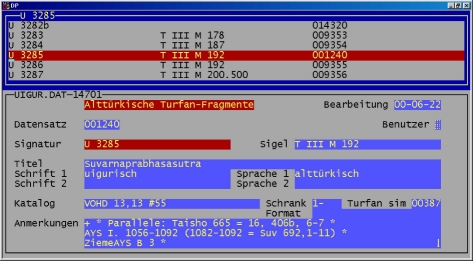
Screenshot of the Database for the administration of the manuscript fragments
The digitisation of all the Berlin Turfan fragments was and is an ambitious, work-intensive and expensive project made been possible only by the financial support of the DFG – the German Research Foundation. In 1997 the DFG – following a UNESCO initiative – set up a programme for the retro-digitisation of library holdings and made funds available. The digitisation of the Berlin Turfan texts is therefore one of the first of such projects sponsored by the DFG.
In the period autumn 1997 – June 2005 the digitisation and internet presentation of the 8500 Old Turkish, 5000 Middle Iranian and 100 Mongolian text fragments of the Berlin Turfan Collection was achieved. The aim was and is to protect the originals, reproduce the archive and to make the texts available in the internet. In its initial phase, the project made use of the experience of a digitisation project at the University of Frankfurt am Main. There, from 1995 on, in the framework of the TITUS project (»Thesaurus Indogermanischer Text- und Sprachmaterialien«) the Tocharian Turfan texts have been worked on electronically. The Tocharian original manuscripts were also digitised, but in order to achieve the highest possible quality and also for conservatory reasons it was decided to make colour slides first and then scan these with a high-resolution scanner. The electronic texts are collated with the digitised originals and, if necessary, modified. The digitisation of the Tocharian fragments was generously supported by the private Tamai Foundation.
The first phase of the project initiated by the Turfanforschung in cooperation with the State Library Berlin – Prussian Cultural Heritage restricted itself to producing digital images of the Old Turkish, Middle Iranian and Mongolian Turfan texts in the manner described above and storing them on various storage systems. As far as possible, the necessary conservation and restoration work is carried out before the glassed fragments are photographed. World-wide access to the digitised fragments is made possible through the internet portal of the Academy project Turfanforschung (option Digitales Turfanarchiv Iin the menu). This gives the user a short description of the project and access to the digital archive. The user proceeds to a general view of the sub-groups (i.e. signature groups) of the Old Turkish, Middle Iranian and Mongolian Turfan texts. The user chooses one of these and can look at the fragments in the signature group one after the other. If available, pdf-files containing information on published catalogue descriptions of the fragments are added. In the DTA I there are 28,465 digital images of 14,480 Turfan fragments.
In November 2005 as a result of a joint application of the Berlin Brandenburg Academy of Sciences and Humanities and the State Library Berlin – Prussian Cultural Heritage, the DFG project »Digitisation of the Chinese and Tibetan Turfan texts« began. The basis of this project is a cooperation agreement concluded in 2005 with the International Dunhuang Project (IDP) of the British Library, London. In this framework not only the basic digital information but also the metadata on the individual fragments (identification, catalogue entries, bibliographical details reflecting the current state of research) are captured and are made easily accessible in the presentation in database form (the IDP database) with various search capabilities. Placement in the IDP database also allows access to the Berlin material through a common portal of the Central Asian collections in London, Beijing, St. Petersburg and Kyoto. On the basis of the cooperation agreement a German language version of the internet presence of the International Dunhuang Project was constructed (http://idp.bbaw.de/).
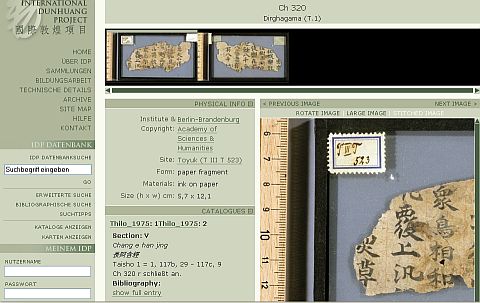
Screenshot of the IDP Database
Information on the current state of the digitisation of these text groups is given on the home page of the Turfanforschung.
A new project for digitising, archiving and presenting the Syriac and Sanskrit manuscripts of the Berlin Turfan Collection in the internet is in preparation. Upon its successful completion the whole text material of the Berlin Turfan Collection will then be digitally secured and available on the internet.
a) VATEC project
VATEC signifies »Vorislamische alttürkische Texte – elektronisches Corpus« (»Pre-Islamic Old Turkish Texts — Electronic Corpus«) and is a database project. It is being elaborated as a cooperation between the Johann Wolfgang Goethe University Frankfurt (Institut für Orientalische und Ostasiatische Philologien; Institut für Vergleichende Sprachwissenschaft, Phonetik und Slawische Philologie), the Georg August University Göttingen (Seminar für Turkologie und Zentralasienkunde) and the Berlin-Brandenburg Academy of Sciences and Humanities (Akademienvorhaben Turfanforschung). The VATEC project is funded by the German Research Council (DFG).
The aim of the project is to record electronically in a unified manner and in accordance with current knowledge the non-Islamic Old Turkish texts (manuscripts and prints) that have already been published or are being edited. At the same time the readings given in the editions are checked with the originals or with photographs or facsimiles. Since in some cases the nearly one hundred years old first edition of the sources was made on the basis of much less knowledge about the language, the VATEC versions can partly be seen as new editions.
In relation to the lines of the original text the database is constructed to show the following elements: 1. Reference, 2. If necessary, a reference to parallel passages in other manuscripts, 3. Transliteration, 4. Precise transcription, 5. Normalised transcription, 6. An interlinear morphological analysis on three levels (morphological parsing), glossing (literal translation of the word stems and description of the grammatical forms), indication of word type or, in suffixes, functional classes (part of speech), 7. German or English translation and 8. Commentary as necessary.
The reference is the signature of the line and contains a reference to the text corpus or to the edition, to the manuscript and sometimes where it is kept, to the page, side of page as necessary and finally, the number of the line.
For greater accuracy a »rough transcription« is created besides the transliteration and the transcription: It includes the orthographical and other peculiarities of the particular manuscript and indications of damage, conjectures and additions. The normalised version of this (the transcription) forms the basis of the grammatical analysis.
The morphological analysis is performed semi-automatically (in the program Shoebox) the precondition for which is that, parallel to entering the text, a lexicon structured as a database is created. This lexicon contains not only the word stems with German meanings and definitions of word type but also all the suffixes with indications of their functions and function classes. A tailor-made computer routine compares the different lexica that are created in parallel in Frankfurt, Göttingen and Berlin from time to time and combines them into one.
At the present time the texts entered into VATEC are available as a CD-ROM which can be obtained from the project office in Frankfurt. The internet presentation of the results of VATEC is:
http://vatec2.fkidg1.uni-frankfurt.de
Further details on the project can be found under:
http://vatec2.fkidg1.uni-frankfurt.de/konv.htm
The various search options facilitate the work with the corpus of texts:
http://vatec2.fkidg1.uni-frankfurt.de/vatecasp/query.htm
For the future, direct access from the VATEC texts to the Digital Turfan Archive is planned.
Screenshot of the VATEC database
b) MIRTEXT
Starting with material that S.N.C. Lieu, partly in cooperation with D.N. MacKenzie and W. Sundermann, collected for a corpus of Manichaean texts, Manichaean Database, D. Durkin-Meisterernst made a database to hold the text material primarily with descriptive and lexicological purposes in mind. This relational database contains in linked tables: texts, word forms, a glossary as well as concordances of lines and sentences and by now contains the entire published Parthian and Middle Persian text material from Turfan to which the unpublished material is being added successively. A similar database has been prepared for the Sogdian material. The Parthian and Middle Persian database has already served as the basis for the dictionary of Manichaean Parthian and Middle Persian in the Manichaean Dictionary Project of the School of Oriental and African Studies in London.
Screenshot of the MIRTEXT database
The structure of MIRTEXT is:
Line (›Zeile‹) > Text > Forms (›Formen‹) > Glossary (›Glossar‹)
> Sentence (›Satz‹)
These are the names of tables that contain information in separate fields. The tables are named here in the order in which they are created or in which information is placed in them. Since the table Sentence is not created until a later stage it has been placed in the bottom line. The core of the database is the table Text that contains a separate entry in the field »word« for each word of the texts. Directly linked with this table are the tables Line, Forms and Sentence (i.e. these tables are in a relation to the first table). The table Glossary is linked to the table Forms and not directly to the table Text.
In the illustration the tables and their fields can be seen. The word pdw’c’h is analysed in the table Forms as »subj.2.sg.« and is placed under the lemma pdw’c- in the table Glossary. On the top right are the tables Line and Sentence. The table Sentence contains the complete sentence »And answer me!«. The table Line has no content in this example because the text has been compiled from duplicates.
The particular condition of the texts from Turfan mean that an effective way of dealing with duplicates is important. The method used in the database is modelled on the presentation given by W. Sundermann in synoptic editions. The table Duplicates (»Duplikate«) contains the basis for the compiled text, i.e. the diplomatic edition of all the witnesses of the text. The table Duplicates contains the exact form of the attested word with a reference (i.e. manuscript number and line), the table Text contains only the word established on the basis of the witnesses with a reference (i.e. text abbreviation and paragraph or verse number).
MIRTEXT has further functions that are useful when new texts are being added. The texts from Turfan belong to the corpus languages, i.e. to languages with limited text material, but the edges of the corpora have not yet been reached. Neither have all the available texts been published nor can we exclude that new texts will be found. Furthermore, established readings can occasionally be improved on. In the face of this indefinite situation the opportunity given by the database to reflect in virtual word lists and concordances the latest changes in the readings as well as newly added texts is very valuable. Thus we have a working aid that cannot be provided so easily by printed concordances etc.
Furthermore, the database can be used to record translated and original texts together. Since the individual word is the basis for the work in the database the corresponding words from one text are added to the words of the text in the other language. This is a time-consuming procedure because the person working on the text has to manually fit the texts together. The result is a list of the relative distribution of the words in both languages and this can, for example, form part of a dictionary. This is a tool that can be used at various stages of work on a text. In the case of rare words, reference to the text from which the translation has been made is as a rule decisive for establishing the meaning of these words; in the case of a text already edited the translation technique can be studied in order to establish how the translator dealt with the original.
c) TITUS
As part of the creation and collection of digital language materials in the Indoeuropean languages digital archives of the published Middle Iranian materials from, amongst others, the Turfan collection have been created in TITUS (»Thesaurus indogermanischer Text- und Sprachmaterialien«, since 1987 at the University of Frankfurt a.M. under the guidance of Prof. J. Gippert; there amongst other things, a presentation of the Tocharian texts in the Turfan collection). The texts are stored in the powerful concordance programme WordCruncher that allows searching according to language. The texts can be presented in various ways: Transliteration and transcription can be searched in tandem, a reproduction of the original text can also be included. TITUS also contains Middle Iranian texts that are not from Turfan but which must be consulted during the work on the Turfan texts (e.g. Zoroastrian Middle Persian and Sogdian material as well as an archive of Saka).
Though it is in printed form that the Middle Iranian and Turkish texts are available today as publications, the digitisation of the work on the texts has emancipated itself from the function of preparing a printed publication and the internet will allow this to step clearly into the public sphere. This is accompanied by a digitisation of the fragments themselves (see Digital Turfan Archive) with the longer term aim of being able with the help of a digital catalogue to record and retrieve both the fragment and the text.
[For TITUS see: http://titus.fkidg1.uni-frankfurt.de/texte/tocharic/tht.htm]
At irregular intervals the collaborators of the Turfan Study group and other interested colleagues meet to hear lectures by invited guests or to present problems from their own work. The titles of the lectures can be seen on the homepageof the Academy project. We also participate regularly in the Berlin »Asia and Pacific weeks« with a dedicated event.
Since 1999 selected lectures have been appearing in print under the title of »Collegium Turfanicum« in the »Berichte und Abhandlungen der BBAW«:
K. Kudara: Silk Road and its culture – The view of a Japanese scholar – (Lecture in the framework of the East Asian and Pacific weeks of the city of Berlin on the 18th of September 1997). In: BBAW Berichte und Abhandlungen Bd. 6, Berlin 1999, 331–347.
T. Moriyasu: The West Uighur Kingdom and Tunhuang around the 10th–11th centuries (Lecture at the BBAW on the 10th of May 1999). In: BBAW Berichte und Abhandlungen Bd. 8, Berlin 2000, 337–368.
Y. Yoshida: In search of the traces of Sogdians. »Phoenicians of the Silk Road« (Lecture at the BBAW on the 5th of October 1999). In: BBAW Berichte und Abhandlungen Bd. 9, Berlin 2002, 185-200.
Rong Xinjiang: New Light on Sogdian Colonies along the Silk Road: Recent Archaeological Finds in Northern China (Lecture on the 20th of September 2001, in the framework of the Asia and Pacific weeks of the city of Berlin 2001). In: BBAW Berichte und Abhandlungen Bd. 10, Berlin 2006, 147-160.
Appendix:
PDF

